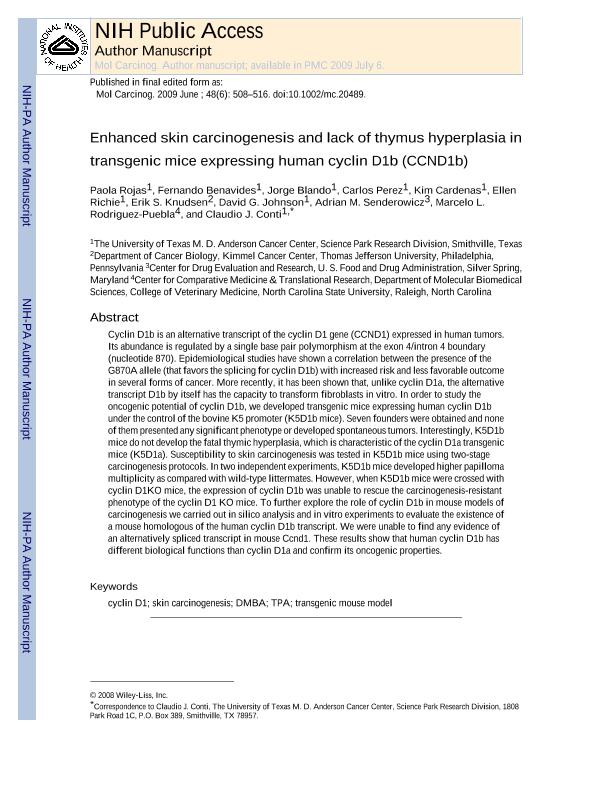Artículo
Enhanced skin carcinogenesis and lack of thymus hyperplasia in transgenic mice expressing human cyclin D1b (CCND1b)
Rojas, Paola Andrea ; Benavides, Fernando; Blando, Jorge; Pérez, Carlos; Cardenas, Kim; Richie, Ellen; Knudsen, Erik S.; Johnson, David G.; Senderowicz, Adrian M.; Rodriguez Puebla, Marcelo L.; Conti, Claudio
; Benavides, Fernando; Blando, Jorge; Pérez, Carlos; Cardenas, Kim; Richie, Ellen; Knudsen, Erik S.; Johnson, David G.; Senderowicz, Adrian M.; Rodriguez Puebla, Marcelo L.; Conti, Claudio
 ; Benavides, Fernando; Blando, Jorge; Pérez, Carlos; Cardenas, Kim; Richie, Ellen; Knudsen, Erik S.; Johnson, David G.; Senderowicz, Adrian M.; Rodriguez Puebla, Marcelo L.; Conti, Claudio
; Benavides, Fernando; Blando, Jorge; Pérez, Carlos; Cardenas, Kim; Richie, Ellen; Knudsen, Erik S.; Johnson, David G.; Senderowicz, Adrian M.; Rodriguez Puebla, Marcelo L.; Conti, Claudio
Fecha de publicación:
06/2009
Editorial:
Wiley
Revista:
Molecular Carcinogenesis.
ISSN:
0899-1987
e-ISSN:
1098-2744
Idioma:
Inglés
Tipo de recurso:
Artículo publicado
Clasificación temática:
Resumen
Cyclin D1b is an alternative transcript of the cyclin D1 gene (CCND1) expressed in human tumors. Its abundance is regulated by a single base pair polymorphism at the exon 4/intron 4 boundary (nucleotide 870). Epidemiological studies have shown a correlation between the presence of the G870A allele (that favors the splicing for cyclin D1b) with increased risk and less favorable outcome in several forms of cancer. More recently, it has been shown that, unlike cyclin D1a, the alternative transcript D1b by itself has the capacity to transform fibroblasts in vitro. In order to study the oncogenic potential of cyclin D1b, we developed transgenic mice expressing human cyclin D1b under the control of the bovine K5 promoter (K5D1b mice). Seven founders were obtained and none of them presented any significant phenotype or developed spontaneous tumors. Interestingly, K5D1b mice do not develop the fatal thymic hyperplasia, which is characteristic of the cyclin D1a transgenic mice (K5D1a). Susceptibility to skin carcinogenesis was tested in K5D1b mice using two-stage carcinogenesis protocols. In two independent experiments, K5D1b mice developed higher papilloma multiplicity as compared with wild-type littermates. However, when K5D1b mice were crossed with cyclin D1KO mice, the expression of cyclin D1b was unable to rescue the carcinogenesis-resistant phenotype of the cyclin D1 KO mice. To further explore the role of cyclin D1b in mouse models of carcinogenesis we carried out in silico analysis and in vitro experiments to evaluate the existence of a mouse homologous of the human cyclin D1b transcript. We were unable to find any evidence of an alternatively spliced transcript in mouse Ccnd1. These results show that human cyclin D1b has different biological functions than cyclin D1a and confirm its oncogenic properties.
Palabras clave:
Cyclin D1
,
Skin Carcinogenesis
,
Dmba
,
Tpa
Archivos asociados
Licencia
Identificadores
Colecciones
Articulos(IBYME)
Articulos de INST.DE BIOLOGIA Y MEDICINA EXPERIMENTAL (I)
Articulos de INST.DE BIOLOGIA Y MEDICINA EXPERIMENTAL (I)
Citación
Rojas, Paola Andrea; Benavides, Fernando; Blando, Jorge; Pérez, Carlos; Cardenas, Kim; et al.; Enhanced skin carcinogenesis and lack of thymus hyperplasia in transgenic mice expressing human cyclin D1b (CCND1b); Wiley; Molecular Carcinogenesis.; 48; 6; 6-2009; 508-516
Compartir
Altmétricas



